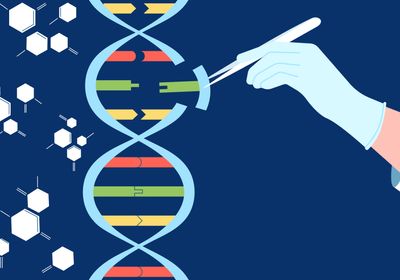ABOVE: Researchers investigated the inadvertent genotoxicity that arises from CRISPR-Cas9 gene editing in T cells and stumbled upon a solution. ©iStock, LadadikArt
Thanks to gene editing tools such as CRISPR-Cas technologies, researchers can now insert, delete, or replace genomic DNA at specific target sites to inactivate genes, acquire new traits, and correct genetic mutations.1 The well known CRISPR-Cas9 system relies on a guide RNA that directs the Cas9 enzyme to a desired DNA sequence, which the enzyme cuts, forming double-strand breaks (DSB). One important application for CRISPR-Cas9 technology is potentially boosting the immune response in patients with cancer by engineering autologous T cells to target and destroy tumor cells.2
While CRISPR-Cas9 genome editing enables advanced T cell therapies, scientists have safety concerns.3 Improper DSB repair can lead to the loss of Cas9-targeted chromosomes, but these unintended effects remain largely unexplored. “There were a couple of papers in the field that showcased this [chromosome loss], but nothing that was very comprehensive,” said Connor Tsuchida from the University of California, Berkley and founder of the biotech company Stealth Startup. In his recently published paper in Cell, Tsuchida and his colleagues reported how widespread the Cas9-induced chromosomal loss was when editing human T cells.4
To investigate how Cas9 gene editing affected T cells, the researchers targeted the first exon of the TRAC locus, which encodes the T cell receptor on chromosome 14. As expected, DNA sequencing results showed that the intended locus was edited. However, when the researchers analyzed the cells’ transcriptome-wide single-cell RNA sequencing (scRNA-seq) data, they detected reduced gene dosage on chromosome 14 and found that five to 20 percent of the T cells exhibited partial or whole chromosome loss.
To further look at the chromosome loss phenomenon, Tsuchida and his colleagues used CRISPR-Cas9 to edit multiple genes on every somatic chromosome. They found that chromosome loss occurred for almost 90 percent of all targets, no matter where the edit occured. Taken together, these results suggested that chromosome loss from T cell genome editing is a general feature of Cas9 editing across target sites.
The researchers then assessed the consequences of Cas9-induced chromosome loss. They monitored edited cells in vitro for two to three weeks, a timeframe similar to current clinical adoptive T cell therapy manufacturing protocols, and found that although these cells survived, they had detectable levels of chromosome loss throughout and showed reduced proliferation and fitness. Therefore, compromised T cells with Cas9-induced chromosome loss could persist long enough during cell therapy manufacturing to end up in patients. The researchers also saw significant overexpression of two gene modules in these cells: the p53 DNA damage response and general apoptosis pathways.
The researchers wondered if they could find evidence of engineered T cell chromosome loss in existing clinical trials.2 They investigated scRNA-seq data throughout a trial completed in 2020, where patients with advanced, refractory cancer received CRISPR-Cas9-edited T cells, called NY-ESO-1 transduced CRISPR 3X edited cells (NYCE cells). “We didn't find any [chromosome loss] at all, which was surprising for us,” said Tsuchida.
After investigating several factors that may explain this discrepancy, Tsuchida and his colleagues found a key difference in the clinical trial’s T cell engineering protocol. In Tsuchida’s study, and in nearly all other clinical trials testing genome-edited T cells, CRISPR editing occurred after T cell activation and stimulation. In contrast, the NYCE cells were edited before activation, which may have decreased chromosome loss.
“The important part is that [Tsuchida’s team] demonstrated a way to mitigate unintended chromosome loss by changing the protocol,” said Ayal Hendel, a CRISPR editing researcher from Bar-Ilan University, who was not involved with this study. “They demonstrated that if you first take the T cells, induce edits, and only later start with the activation … you get less chromosome loss. This is the main new aspect of this paper.”
To further understand the difference between these two protocols, the researchers looked at TP53 expression. This gene encodes the p53 protein involved in the DNA damage response and T cell activation. They found that TP53 expression after CRISPR-Cas9 editing inversely correlated with rates of chromosome loss. The researchers speculated that when engineering NYCE cells, high TP53 expression may have favored cells with intact chromosomes. Modulating p53 while following the NYCE protocol may help protect CRISPR-engineered cells against aneuploidy. “[Treating cells] with small molecules that either activate p53 or inactivate an inhibitor of p53 before genome editing … may [offer] transient protection,” Tsuchida hypothesized. “It's something we are interested in getting into.”
References:
- Xu Y, et al. CRISPR-Cas systems: Overview, innovations and applications in human disease research and gene therapy. Comput Struct Biotechnol J. 2020;18:2401-2415.
- Stadtmauer EA, et al. CRISPR-engineered T cells in patients with refractory cancer. Science. 2020;367(6481):eaba7365.
- Nahmad AD, et al. Frequent aneuploidy in primary human T cells after CRISPR-Cas9 cleavage. Nat Biotechnol. 2022;40(12):1807-1813.
- Tsuchida CA, et al. Mitigation of chromosome loss in clinical CRISPR-Cas9-engineered T cells. Cell. 2023;186(21):4567-4582.e20.









